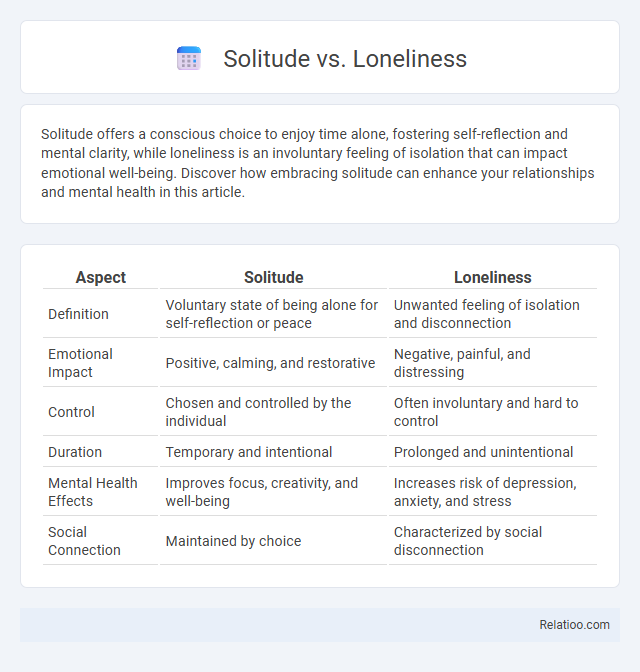Solitude offers a conscious choice to enjoy time alone, fostering self-reflection and mental clarity, while loneliness is an involuntary feeling of isolation that can impact emotional well-being. Discover how embracing solitude can enhance your relationships and mental health in this article.
Table of Comparison
| Aspect | Solitude | Loneliness |
|---|---|---|
| Definition | Voluntary state of being alone for self-reflection or peace | Unwanted feeling of isolation and disconnection |
| Emotional Impact | Positive, calming, and restorative | Negative, painful, and distressing |
| Control | Chosen and controlled by the individual | Often involuntary and hard to control |
| Duration | Temporary and intentional | Prolonged and unintentional |
| Mental Health Effects | Improves focus, creativity, and well-being | Increases risk of depression, anxiety, and stress |
| Social Connection | Maintained by choice | Characterized by social disconnection |
Understanding Solitude and Loneliness
Solitude is a conscious state of being alone that promotes self-reflection, creativity, and mental clarity, offering a peaceful retreat from external distractions. Loneliness, however, is an involuntary feeling of sadness or isolation stemming from a lack of meaningful social connections, often leading to emotional distress. Understanding the distinction between solitude and loneliness is crucial for recognizing the benefits of intentional alone time versus the negative impact of social disconnection.
Key Differences Between Solitude and Loneliness
Solitude is a chosen state where You embrace being alone to recharge and reflect, offering mental clarity and peace. Loneliness, however, is an unwanted feeling of isolation often associated with sadness and emotional distress. Alone time provides the intentional opportunity for self-care, distinguishing it from the negative experience of loneliness by promoting personal growth and well-being.
The Psychological Impact of Solitude
Solitude offers a psychological refuge that promotes self-reflection, emotional clarity, and mental restoration, differentiating it from loneliness, which often triggers feelings of isolation and distress. Engaging in alone time intentionally can enhance creativity, reduce stress hormones like cortisol, and improve overall emotional resilience. Neuroscientific studies reveal that controlled solitude activates brain regions associated with self-awareness and emotional regulation, underscoring its importance in maintaining psychological well-being.
The Emotional Toll of Loneliness
Loneliness, distinct from solitude or alone time, imposes a profound emotional toll by triggering feelings of isolation and sadness that can negatively affect mental and physical health. Unlike solitude, which is a chosen state fostering self-reflection and rejuvenation, loneliness is involuntary and often accompanied by a sense of disconnection from others. Understanding the difference empowers you to address loneliness proactively and seek meaningful social connections to improve overall well-being.
Benefits of Embracing Solitude
Embracing solitude enhances self-awareness and mental clarity, offering a powerful opportunity for introspection and personal growth. Unlike loneliness, which stems from isolation, solitude is a chosen and restorative experience that can boost creativity and emotional resilience. Your ability to enjoy alone time fosters independence and deeper connection with your inner self, promoting overall well-being.
Risks Associated with Chronic Loneliness
Chronic loneliness significantly increases the risk of mental health disorders, including depression and anxiety, while also contributing to cardiovascular diseases and weakened immune function. Unlike solitude or alone time, which can foster self-reflection and creativity, prolonged loneliness often leads to negative physiological changes, such as elevated cortisol levels and increased inflammation. Understanding how loneliness differs from healthy solitude can help you manage your emotional well-being and reduce these serious health risks.
Societal Perceptions: Alone vs. Lonely
Societal perceptions often conflate being alone with feeling lonely, yet solitude represents a positive, intentional state of enjoying your own company without negative emotions. Cultural norms tend to stigmatize alone time as isolation or loneliness, overlooking its critical role in mental well-being and self-reflection. Understanding these distinctions helps you embrace solitude as a healthy practice rather than misinterpreting it as social alienation.
How to Cultivate Healthy Solitude
Cultivating healthy solitude involves intentionally seeking time alone to recharge and reflect, distinguishing it from loneliness, which is marked by feelings of isolation and sadness. Practices such as mindfulness meditation, journaling, and engaging in hobbies during alone time enhance self-awareness and emotional well-being. Creating a balanced routine that includes solitude supports mental clarity and strengthens resilience against the negative effects of social disconnection.
Transitioning from Loneliness to Solitude
Transitioning from loneliness to solitude involves shifting your perspective to embrace alone time as an opportunity for self-reflection and personal growth. Loneliness often feels like isolation with negative emotions, while solitude provides a peaceful state where you can recharge and reconnect with your inner self. Cultivating solitude helps transform feelings of emptiness into purposeful moments of calm and creativity.
Solitude and Loneliness in the Digital Age
Solitude offers a purposeful retreat from the constant digital noise, allowing you to recharge and foster creativity, whereas loneliness in the digital age often stems from superficial online interactions that lack genuine connection. Understanding the difference between solitude and loneliness is crucial as digital platforms can blur these experiences, turning valuable alone time into feelings of isolation. Embracing solitude intentionally enhances mental well-being and counters the loneliness epidemic fueled by social media's paradox of connection without true companionship.

Infographic: Solitude vs Loneliness
 relatioo.com
relatioo.com